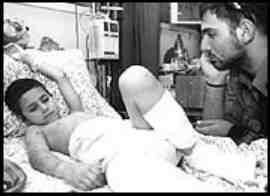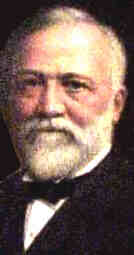Deaths which
occurred on a 25 November:
2001 Johnny Micheal "Mike" Spann, 32, some United Front fighters,
and hundreds of Taliban fighters recently taken prisoners in Kunduz,
Afghanistan, by US airstrikes and Northern Alliance (= United Front)
troops, after the prisoners seize weapons from their guards, capture
an ammunition depot, and take over the Qalai Janghi fortress where they
were held. Fighting continues until 27 November. Spann was an agent of
the CIA's Directorate of Operations, there to interrogate prisoners,
and is the first US person killed in combat in this conflict.
2001 Lameck Chemvura, 22, university student, beaten, strangled
with a shoelace, and then thrown out the window of a moving train by
Zimbabwean soldiers, who accused passengers on the train bound for the
eastern city of Mutare of supporting the opposition party Movement for
Democratic Change. On 27 November, University of Zimbabwe's Harare students
would riot over the killing.
2000 Tayser al-Araj, 13, Palestinian killed by Israeli gunfire
at Khan Yunis in the Gaza Strip. With three other Palestinians killed
this day in the West Bank, this totals some 250 Palestinians and 40 Israelis
killed in the 2-month-old al-Aqsa intifadah. There have been thousands
wounded, and much property damage: vehicles on both sides, and Palestinian
homes and orchards bulldozed.
1998 Kayla McKean, 6, beaten
to death by her father Richard Adams, 24, in Orlando..
State documents show that child
welfare workers missed several chances to intervene and perhaps
save Kayla's life in the months before she was beaten to death
by her father. The documents show that in one instance, welfare
investigators withheld information that could have led to Kayla's
removal from her father's home. They apparently failed to interview
a doctor who said the girl's life was in ``imminent danger.''
And they didn't challenge her father's contention that bicycle
accidents or the family dog caused her injuries.
Adams, 24, slammed Kayla against
a wall and struck her with a paddle after she soiled her underwear.
He buried her in a forest some 80 km.
In October 1998, a Child Welfare
agency supervisor said in a report that Adams could benefit
from parenting and anger-management classes. No one told Adams
about the recommendation.
Lake County child welfare workers
first investigated when Adams took Kayla to a hospital in May
1998. He had assumed custody of the girl weeks earlier after
her mother, Adams' former girlfriend, entered a battered woman's
shelter. Kayla had two black eyes and a broken nose and left
hand. In the emergency room, Adams said Kayla had fallen off
her bike. As is the policy when a child is taken with suspicious
injuries to an emergency room, child welfare workers placed
her in a foster home and asked for a hearing on whether she
should be removed from Adams' home. But in a report to Judge
Jerry Lockett, a child welfare investigator mentioned only Kayla's
black eyes and swelling, not the other injuries, and recommended
the girl stay with her father. The judge agreed.
In June 1998, Kayla was taken
to a doctor for treatment of an eye injury and for bruises all
over her body. Adams admitted he had hit Kayla with a paddle
but denied bruising her. The doctor said Kayla was "in
imminent danger'' while in her father's care. Apparently, no
investigator interviewed the doctor.
The month before she was killed,
child welfare workers investigated a bump on Kayla's head, a
chin abrasion and black eyes. Adams told them the abrasion was
from a fall in the bathtub and her swollen eyes were the result
of the family's golden retriever stepping on her face while
she slept. Investigators believed his story. |
1987 Harold Washington, 65, first Black mayor of Chicago, dies.
1978: 275 persons
in crash of American Airlines DC-10 on takeoff from Chicago
1974 U Thant, 65, UN Secretary-General (1961-72), in NY of cancer
| 1970 Yukio Mishima,
a prolific writer of Japanese novels, essays, poetry, and traditional
plays, publicly commits a ritual suicide known as seppuku, in
Tokyo, in an attempt to rouse Japan to its pre-war nationalist
ideals. Mishima, born in Tokyo in 1925, published his first
major work, Confessions of a Mask, in 1949. The novel
dealt with the discovery of his homosexuality and his experience
during Japan's war years. Educated in Western traditions, he
increasingly became interested in the culture and customs of
imperial Japan. Perhaps his greatest work was the four-part
Sea of Fertility epic, written between 1965 and 1970,
which spanned Japanese life and events in the twentieth century
and explored the conflicts between traditional Japanese culture
and post-war Westernization. During this time, Mishima, who
had become an expert in traditional martial arts, formed the
Tate no Kai, or "Shield Society," with approximately 100 students.
The organization attempted to revive the traditional Samurai
code of honor. In 1970, Mishima seized a government office,
urged his followers to reject the new Japanese constitution
and rearm the country's military, then committed sepukku, the
ritual suicide of self-disembowelment with a sword also known
as harikari, or "belly slitting." |
1969: 115 Communist and 10 US soldiers as Communists step up attacks
against US troops shielding Allied installations near the Cambodian border.
70. US forces have 70 wounded and lose more than a dozen tanks and tons
of ammunition.
1967 Ossip Zadkine, French artist born on 14 July 1890.
1961 Maria, Teresa, and Minerva Mirabel, brutally murdered in
the Dominican Republic. In 1999 the UN would chose this date as the International
Day for the elimination of violence against women.
1958 Charles F Kettering, 82, invented auto self-starter
1952 Huntington,
mathematician
1944 Some 160 British shoppers,
by Nazi V-2 rocket
A German V-2 missile hit a Woolworth's
department store in New Cross Road, Deptford, killing 160 midday
shoppers. The V-2 was a recent innovation in German ammunition.
Its first operational launch had occurred only two months previously,
on September 6, when two missiles were fired at Paris. Unlike
its predecessor, the V-1 buzz bomb, the V-2 was invulnerable
to antiaircraft guns and fighters. Upon launching, the forty-six-foot-long
rocket-propelled missile rose vertically to an altitude of about
six miles, then arced upward to about fifty miles. At its apex,
the missile automatically cut off its own fuel, tipped over,
and sailed downward toward its target at nearly 4,000 mph. The
entire flight lasted no longer than four minutes and wielded
an enormous explosive force. In the final months of the war,
the German V-2 campaign against England killed 2,754 people
and seriously injured 6,523 others. Deptford certainly was not
spared in the bloody V-2 campaign. A thirteen-year-old girl
named June Gaida recalled the horrifying experience of that
day. "I remember seeing a horse's head in the gutter," she said.
"Further on there was a pram all twisted and bent, and there
was a little baby's hand still in its woolly sleeve. Outside
the pub, there was a bus and it had been concertinaed, with
rows of people sitting inside, all covered in dust—and dead."
|
1937 Padoa,
mathematician.
1936 Édouard
Goursat, mathematician.
1927 Josez Rippl-Ronai, Hungarian artist born on 23 May 1861.
1924 Jules Worms, French artist born on 16 December 1832.
1914 Some 90'000 Russians and 35'000 Germans in the last two weeks
in Lodz offensive, which German Field Marshal Fredrich von Hindenburg
now calls off 60 km from Warsaw.
1885 Thomas A Hendricks, 66, 21st US Vice-President, 8 months
after taking office
1876 Amerindian children, women,
and men massacred by US Army in retaliation for Little Bighorn
During the so-called Great Sioux
War, US troops under the leadership of General Ranald Mackenzie
destroy the village of Cheyenne living with Chief Dull Knife,
in the Bighorn Mountains near the Red Fork of the Powder River.
The attack is in retaliation against some of the Indians who
had participated in the victory over Custer and his men at Little
Bighorn. Although the Sioux and Cheyenne won one of their greatest
victories at Little Bighorn, the battle actually marked the
beginning of the end of their ability to resist the US government.
News of the "massacre" of Custer and his men reached
the East Coast in the midst of nationwide centennial celebrations
on July 4, 1876.
Outraged at the killing of one
of their most popular Civil War heroes, many Americans demanded
an intensified military campaign against the offending Indians.
The government responded by sending one of its most successful
Indian fighters to the region, General Ranald Mackenzie, who
had previously been the scourge of Commanche and Kiowa Indians
in Texas. Mackenzie led an expeditionary force up the Powder
River in central Wyoming, where he located a village of Cheyenne
living with Chief Dull Knife. Although Dull Knife himself does
not appear to have been involved in the battle at Little Bighorn,
there is no question that many of his people were, including
one of his sons. At dawn, Mackenzie and over
1000 soldiers and 400 Indian
scouts opened fire on the sleeping village, killing many Amerindian
children, women, and men within the first few minutes. Some
of the Cheyenne, though, managed to run into the surrounding
hills. They watched as the soldiers burned more than 200 lodges — containing
all their winter food and clothing — and then cut the throats
of their ponies. When the soldiers found souvenirs taken by
the Cheyenne from soldiers they had killed at Little Bighorn,
the assailants felt justified in their attack.
The surviving Cheyenne, many
of them half-naked, began an 11-day walk north to the Tongue
River where Crazy Horse's camp of Oglalas took them in. However,
many of the small children and old people did not survive the
frigid journey. Devastated by his losses, the next spring Dull
Knife convinced the remaining Cheyenne to surrender. The army
sent them South to Indian Territory, where other defeated survivors
of the final years of the Plains Indian wars soon joined them.
|
1867 Karl Ferdinand Sohn, German artist born on 10 December 1805.
1858 Johannes Reekers, Dutch artist born in 1790.
1790 Plusieurs propriétaires terriens de saint Domingue, massacrés
par les esclaves qui se révoltent. Les mulâtres libres avaient décidé
de défendre les armes à la main la reconnaissance des droits de citoyens
que le décret du 8 mars précédent leur avait accordé, à tous sans distinction
de couleur de peau.
1733 Quillard Pierre Antoine Quilliard, French artist born in
1701.
1694 Boulliau,
mathematician
|
 Françoise
de Sales Aviat was a 19th century French nun who founded the Congregation
of the Oblate Sisters of St. Francis de Sales, dedicated to helping young
women pouring into cities during the Industrial Revolution.
Françoise
de Sales Aviat was a 19th century French nun who founded the Congregation
of the Oblate Sisters of St. Francis de Sales, dedicated to helping young
women pouring into cities during the Industrial Revolution. 

 1835
Andrew Carnegie, steel industrialist, philanthropist.
1835
Andrew Carnegie, steel industrialist, philanthropist.